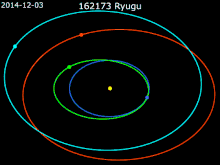495 Eulalia
Eulalia (minor planet designation: 495 Eulalia) is a minor planet orbiting the Sun. Eulalia is very near the 3:1 Jupiter orbital resonance.[3]

Origin of 162173 Ryugu may be either 495 Eulalia or 142 Polana[4]
Sun · Earth · 162173 Ryugu · 142 Polana · 495 Eulalia
Sun · Earth · 162173 Ryugu · 142 Polana · 495 Eulalia
_Eulalia.png.webp) Modelled shape of Eulalia from its lightcurve | |
| Discovery | |
|---|---|
| Discovered by | Max Wolf |
| Discovery site | Heidelberg Observatory |
| Discovery date | 25 October 1902 |
| Designations | |
| (495) Eulalia | |
| Pronunciation | /juːˈleɪliə/ |
Named after | the discoverer's wife's grandmother[1] |
| 1902 KG | |
| Orbital characteristics[2] | |
| Epoch 31 July 2016 (JD 2457600.5) | |
| Uncertainty parameter 0 | |
| Observation arc | 113.10 yr (41309 d) |
| Aphelion | 2.8101 AU (420.38 Gm) |
| Perihelion | 2.1645 AU (323.80 Gm) |
| 2.4873 AU (372.09 Gm) | |
| Eccentricity | 0.12977 |
| 3.92 yr (1432.8 d) | |
| 5.5120° | |
| 0° 15m 4.536s / day | |
| Inclination | 2.2795° |
| 186.478° | |
| 206.971° | |
| Physical characteristics | |
Mean radius | 19.425±0.7 km |
| 28.967 h (1.2070 d) | |
| 0.0571±0.004 | |
| 10.78 | |
It is possible that the disruption of Eulalia's parent body resulted in a mass bombardment of the Earth and Moon 800 million years ago, forming the Copernicus crater on the Moon and involving about 50 times the amount of material of the Chicxulub impact on Earth at the beginning of the Cryogenian geological period.[5]
References
- Schmadel, Lutz D. (2007). "(495) Eulalia". Dictionary of Minor Planet Names – (495) Eulalia. Springer Berlin Heidelberg. p. 54. doi:10.1007/978-3-540-29925-7_496. ISBN 978-3-540-00238-3.
- "495 Eulalia (1902 KG)". JPL Small-Body Database. NASA/Jet Propulsion Laboratory. Retrieved 6 May 2016.
- Walsh, Kevin (2013). "Introducing the Eulalia and new Polana asteroid families: re-assessing primitive asteroid families in the inner Main Belt". Icarus. 225 (1): 783–297. arXiv:1305.2821. Bibcode:2013Icar..225..283W. doi:10.1016/j.icarus.2013.03.005.
- S. Sugita; et al. (19 March 2019). "The geomorphology, color, and thermal properties of Ryugu: Implications for parent-body processes" (PDF). Science. 364 (6437): eaaw0422. doi:10.1126/science.aaw0422. PMID 30890587.
- Terada, K., Morota, T. & Kato, M. Asteroid shower on the Earth-Moon system immediately before the Cryogenian period revealed by KAGUYA. Nature Communications 11, 3453 (2020). https://doi.org/10.1038/s41467-020-17115-6
External links
- Lightcurve plot of 495 Eulalia, Palmer Divide Observatory, B. D. Warner (2012)
- Asteroid Lightcurve Database (LCDB), query form (info)
- Dictionary of Minor Planet Names, Google books
- Asteroids and comets rotation curves, CdR – Observatoire de Genève, Raoul Behrend
- Discovery Circumstances: Numbered Minor Planets (1)-(5000) – Minor Planet Center
- 495 Eulalia at AstDyS-2, Asteroids—Dynamic Site
- 495 Eulalia at the JPL Small-Body Database

This article is issued from Wikipedia. The text is licensed under Creative Commons - Attribution - Sharealike. Additional terms may apply for the media files.
